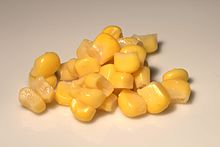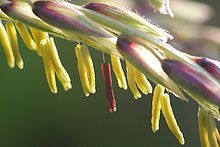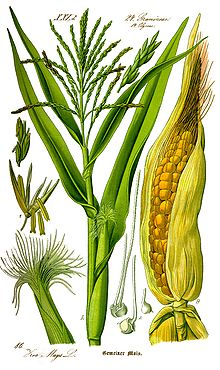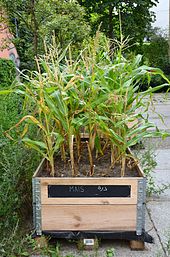Maize
![]()
This article explains the cereal. For other meanings, see Corn (disambiguation).
Maize (Zea mays), also called kukuruz (from Slavic) in parts of Austria and Old Bavaria, is a plant species within the sweet grass family (Poaceae). The cereal originates from Mexico and is a monoecious C4-sexual plant.
The subspecies Zea mays subsp. mays is economically important. Maize is the world's largest cereal crop, accounting for over 1.1 billion tonnes (2017), ahead of wheat and rice. Over 60% of this is processed into corn silage and fed to livestock. In addition, energy corn is used as a renewable raw material for the production of bioethanol and biogas.
The grain corn is one of the staple foods of the population of Africa and Latin America. The gluten-free grain is also suitable for people with hypersensitivity to gluten (celiac disease).
In addition to processing in the food industry, the starch obtained from corn is used as a renewable raw material for the production of bio-based plastics.

Grains of vegetable maize

Corn on the Cob
Description
The cultivated corn is rich in form due to the long breeding history.
Vegetative characteristics
Cultivated maize is a vigorously built, deciduous, annual, herbaceous plant that reaches growth heights of one to three metres. The round, unbranched or rarely branched culm is covered with smooth leaf sheaths along its entire length. It is pithy on the inside and can have a diameter of five centimetres at the base. The numerous nodes stand in dense succession, especially close to the ground. From them develop shoot-like roots that serve to absorb water and nutrients, but above all also to stabilise the plant.
The stem leaves are arranged alternately on the stem. The ligule, which is three to five millimetres long, is slit or ciliated. The simple, slightly rough, sometimes scattered hairy, dark green leaf blade is up to one metre long and four to ten centimetres wide, flat and wavy towards the edge.
Generative characteristics
Cultivated maize is monoecious. The terminal male panicled inflorescences are located at the shoot tip and are composed of spikelets arranged in pairs with two male flowers each on the panicle branches. One to three female inflorescences grow in leaf axils at the base to middle of the culm. These lateral, short-stalked spadices are completely sheathed by bracts (read leaves, also called readlets, pronounced /ˈliːʃən/) and bear paired spikelets in 8 to 16 longitudinal rows. In this, each spikelet contains two flowers, but only one is fully developed. The ovary is very small at three millimeters, but at anthesis is furnished with styles 20 to 40 centimeters long. Later, the withered styles protrude as a brownish bundle from the tip of the cob between the leaf sheaths. Since the lemmas and pistils of the female flowers do not develop further, the fruits can protrude without being fleshed.
At the time of ripening, the cob-shaped fruit stand contains corn kernels (caryopses) which, depending on the variety, can be whitish, golden yellow, red or even blackish purple; the thousand-grain weight is 250 to 400 grams.
The chromosome number of maize is 2n = 20 (40, 80).

Male flowers

Illustration

Schematic structure of the corn plant
Ecology
This therophyte is a summer-annual plant. The support of the tall stem is provided by shoot-borne supporting roots from the nodes at the base of the stem. Stem pith and fruits are at least initially sugary. Stomata are on both sides of the leaf; 95 per square millimeter above, 160 per mm2 below. Maize is a C4 plant, here malate is the first photosynthetic product. The C4 method is an adaptation to very warm and sunny climatic conditions, as they are mainly in the tropics and subtropics. The CO2 supply is used in an optimal way. Especially at high temperatures, maize plants can use CO2 far better for growth than ordinary C3 plants. They also consume less water.
The flowering period (in Central Europe) is from July to September. From the point of view of floral ecology, it is of the "long-pollinated type". The maize is wind-flowered (anemophilous), i.e. the female flowers are pollinated by wind transport of the pollen. The flower is "pre-male", this favours cross-pollination. In pre-masculinity (proterandry), the anthers empty the pollen before the stigma of the flower is ready for conception. The pistil is long and filamentous, so the pollen must travel more than 10 cm to reach the ovule. Only 10,000 pollen grains are produced per flower, but 18 million per inflorescence. With a length of 0.1 mm and a weight of 0.00025 mg, maize pollen is among the largest and heaviest of the plants growing in our region. The pollen is sticky, travels only relatively short distances by wind, and germinates for only about one day. For wind pollinators, the pleasant scent of the pollen is also surprising; in fact, corn is an important pollen source for honeybees.
The corn is a short-day plant, which is why the fruits often do not ripen in our country. The seeds are heat germinators.

Urban gardening: Corn in Berlin-Schöneberg on the Red Island in August 2016
Questions and Answers
Q: What is maize?
A: Maize, also known as Indian corn or corn in some countries, is a cereal grain from the grass family Poaceae. It was first grown by people in ancient Central America.
Q: How much maize is harvested each year?
A: Approximately 1 billion tonnes of maize are harvested every year.
Q: What are some uses for maize?
A: Maize is used to make corn ethanol, animal feed and other maize products such as corn starch and corn syrup.
Q: What type of plant is maize?
A: Maize is an angiosperm, which means that its seeds are enclosed inside a fruit or shell.
Q: Where has maize been a staple food historically?
A: Historically, many people in Mexico, Central and South America and parts of Africa have eaten maize as a staple food. In Europe and the rest of North America, it has mostly been used as animal feed.
Q: How has artificial selection impacted the growth of maize?
A: Through centuries of cross breeding with artificial selection, larger plants and specialized varieties have developed from the original Mexican plant called Teosinte.
Q: What role does corn play in American foods?
A: Corn has become an important ingredient in American foods through the use of corn starch. People eat sweetcorn and popcorn with little processing, while other kinds are processed into flour for making things like cornbread and tortillas.
Search within the encyclopedia